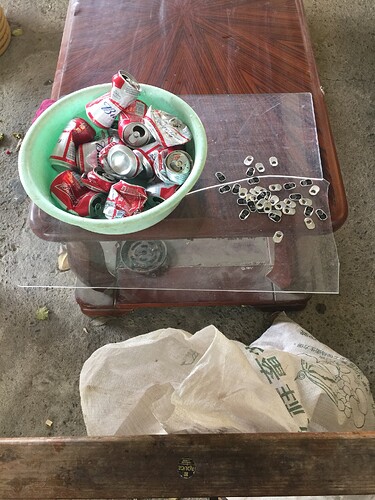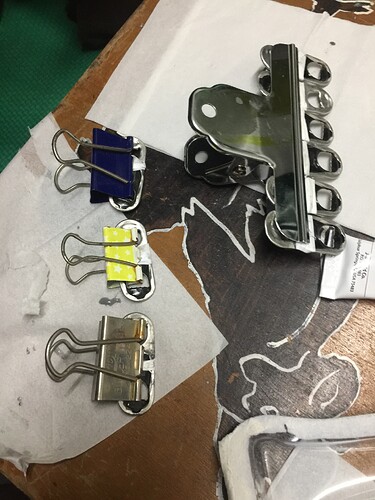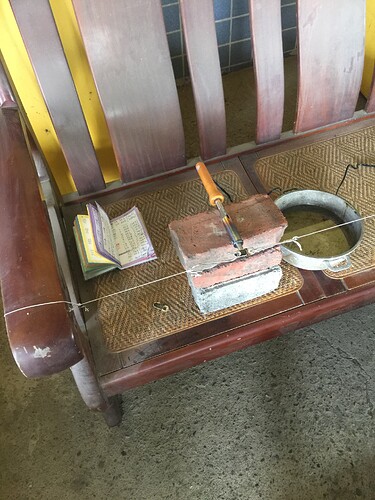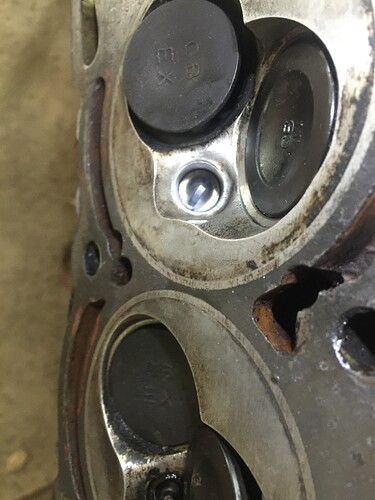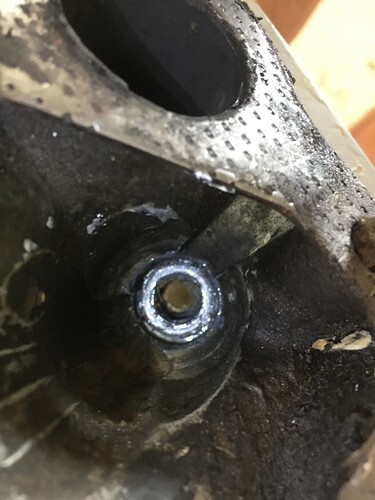@sulavaca just put a Sentra up for sale on Autocheckers Facebook page at a fantastic price, get in touch with him asap as it will go fast gast fast! Jetta fast!
I just sent him a long shaft M14 x 1.25 tap. I hope this will do the trick.
I haven’t been following this thread and I have no real clue what you guys are talking about, but this bit cracked me up. ![]()
You’d be disappointed if you went to this and it wasn’t full of nut jobs
Grate place to hide if you have a screw loose.
Too late. Forgot about it. Losing the thread.
High temp (?) epoxy testing. JB Weld stuff has finally arrived (400NT)(7-11 lost it), and I earlier bought some Bondite stuff (200NT) in a hardware store which doesn’t give a temp spec but mentions exhaust repair on the packaging.
Since it’ll contaminate the surface and block alternatives, worth confirming its temperature resistance before application, if possible.
I used ring-pull tabs from Budweiser beer cans (“the King of Beers” yeh, right) as standard test pieces, which seemed somehow appropriate for testing
“All American” JB Weld.
They have an unpainted aluminium side (which was the gluing surface) and a black painted side, (which I used for IR thermometer upper surface readings, likely to be considerably lower than the temperature in the join).
Two tabs were glued face-to-face, and after curing for 48 hours (24 for rubber and superglue tests) the join was put under shear stress with a weight pulling the tabs apart, and heat was applied with 2 soldering irons (a 60W and a 40W) in contact with the underside of the tabs.
A naked flame (from a candle or cigarette lighter) was found to blow around and give erratic temperature readings so was not used in the tests
The tabs are not perfect for the job, since the edges are crimped over and there is a slight dimple on the surface. For these tests I hammered them flat, washed them with boiling water and detergent and then brake cleaner, rubbed them on a brick, then with a stainless steel wire brush.
This probably introduces uncontrolled variation. If I was doing it again, (not planned) I would skip the hammering and brick rubbing steps
Results
Nan Pao Impact adhesive
Joints all fail immediately or in less than 30 seconds after coming under load.
Superglue Cyanoacrilate Failure Time/Max Observed Surface Temperature
1: 3 mins 18 secs at 39C
2 : 2 mins 56 secs at 33C
3: 3 mins 20 secs at 35C
JB Weld
- No fail in 15 mins/51.9C
- No fail in 15 mins/45.7C
- No fail in 15 mins/53.2C
In my hands these (cheapo hardware store) soldering irons give insufficient heat for reliable soldering, so I repeated the tests with a 100W (cheapo hardware store) soldering iron which was easier to arrange (and probably also gave more consistent, though not necessarily greater, heating).
For this series I also measured the temperature of the exposed part of the iron, which reached a maximum of around 150 to 170C.
JB Weld test pieces used previously (and therefore high temp cured) were compared with Bondite epoxy,
No failures in any samples during a maximum of 40 minutes heating.
Superior heat resistance of JB Weld over Bondite is thus uncomfirmed ATPIT, (would require higher temperatures) but Bondite is a “fast” epoxy (4 mins) so gives insufficient working time and is probably weaker. This seems to be the norm for readily available epoxies.
I would need to figure out greater (but controlled) heating for testing to destruction. GF has an inductive hot plate that might do, but she would probably miss it.
Any luck with the extended shank M14 P1.25 tap TL sent you?
He had me send it to a workplace, so it might be a few days until he picks it up.
I always go to that shop for tooling by the way, they got lots and are sold by weight.
They had some student recruitment thing on yesterday so the office was closed, but I’m told its arrived, thanks. Should pick it up this afternoon.
Be a few days before I try it though, since I’ll be otherwise engaged over the weekend, then finishing the epoxy testing, then, if that goes OK, a couple of days cure of epoxy applied to the spark plug hole before it’ll be (hopefully) ready for tapping.
Non-inductive hotplate in combo with a trad copper soldering iron (intended for use with a blowlamp) as a spacer gets test piece up to 150-200C, probably about the righr ball park. No fail of Bondite sample in 40 mins.
Indiv testing takes too long but I should be able to set up parallel testing when I get back on it.
Well, this is embarrassing.
As a preliminary to gooping up the damaged thread with HT epoxy, I inserted the plug as far as it would go (about halfway), put a drinking straw in the centre of the other side, and tamped lightly greased aluminium foil down around it to protect the intact threads from the epoxy.
I had thin polythene sheet over the plug to protect the clean threads from any stray grease.
Bubble straw was too wide and flexible, so I repeated with a pen barrel wrapped in PTFE tape, which worked better.
The single layer of polythene sheet had torn, so I used three, and the plug wound all the way into the head.
IOW all this palaver could have been avoided at no cost and in about a minute, by adding polythene sheet to the plug.
I’d guess polythene will melt and char, but I can’t see it doing much harm. PTFE tape is more heat tolerant, but might release fluoric acid on cooking. Oven compatible cling film might be a better choice.
I’ve been using polythene sheet as a low temp antiseize treatment (for example, on wheel studs) for years, since antiseize is pretty much Unobtainium here in Taiwan, so I might have been expected to think of trying it, but no.
Should probably have abandoned the epoxy plan but inertia/sunk costs too powerful, so the thread is gooped up and awaits tapping
What about just chasing the thread with the tap? Epoxy won’t really work just taking up the worn portion of a thread, you should be trying to helicoil the thing. Epoxy really needs a minimum thickness of around 1mm for it to hold integrity.
I’ve watched some video on spray weld repairs from Abom79 on YouTube, he would actually machine the stuff about 1mm smaller then build it up with spray welds. Epoxy is weak compared to spray welds.
Having gooped it up with epoxy, I’m sort of committed by the epoxy on it, to tapping the epoxy.
I have actually done a pretty good MIG weld on aluminium, once. Sectioned and acid-etched, it showed good root penetration, and a nice neat bead, but it was a minor part of my welding course (I’ve mostly used oxy-acetylene) and was probably a fluke.
IIRC it used argon as a shielding gas.
This was a long time ago and I have no access to welding gear now.
Plus its gooped up with epoxy.
How do you plan to enlarge the hole to the right size?
. . . since antiseize is pretty much Unobtainium here in Taiwan . . .
You mean this stuff?:
Easily obtainable in Taiwan. I use it regularly for flaring pipes. Good to 870C.
Never seen that here. I have seen a 500g tin of Copaslip in the good Ktown tool shop, but that would last me until the heat death of the universe.
Sulavaca is on record as saying I probably found the only tin in Taiwan, since its unknown in the garage trade here. He said he orders his specially and his supplier told him he was the only customer for it.
I bought a small tube of aluslip in Japan, maybe the same stuff as in your Internyet picture, but mostly I use more available substitutes, like polythene.
I picked the compressed aluminium foil out apart from an annular ring that I couldn’t shift, which had probably been infiltrated with epoxy, which I just tapped through.
I coated the tap with candle wax in an attempt to protect the intact threads. I used a spray grease in the hole, which probably wasn’t thick enough for the job, and also meant I could see the tap removing aluminium from the intact threads, which I didn’t enjoy, so after a while I gooped it all up with a heavier (I assume molybdenum)grease salvaged from a scrap CV boot.
AFAIK you can’t easily get international brands of grease in Taiwan. This is probably because grease (unlike oil) is mostly a pro product, and the pros don’t care.
Got quite hard to move when it hit the epoxy, but I elected not to remove it and clean the flutes because I was concerned about further damage to the intact threads. This was probably a mistake.
Plug now runs all the way in, so assuming it doesn’t blow out when/if the engine runs, I guess its fixed
HUZZAH!
If I was doing this again (hope not) I might use epoxy-reinforced compressed aluminium as the “filler”, though I don’t know if any epoxy was retained in the threads and it may be the tap alone did the job.
I would have preferred to try a forming tap first, but that turned out to be another case of Taiwan Unobtanium.
Thanks to all for your help to date.
Now I just have to put it back together and hope that cylinder liner doesn’t perforate.
Oops. Another self-inflicted issue.
Attempting to improvise a piston ring compressor from a thin plastic tea cup (slightly conical. Perfect for the job thinks I) I got the piston stuck in the bore,
Its very firmly stuck, likely requiring drastic action to free it.
IF y’all had such a problem (OK, I know YOU wouldn’t, but if you did) how might you address it?
Sulavaca is on record as saying I probably found the only tin in Taiwan, since its unknown in the garage trade here. He said he orders his specially and his supplier told him he was the only customer for it.
It seems to be readily available but the stores in this link copaslip - Prices and Deals - Jun 2023 | Shopee 蝦皮購物 indicate not a single sale!
AFAIK you can’t easily get international brands of grease in Taiwan. This is probably because grease (unlike oil) is mostly a pro product, and the pros don’t care.
I think they’re easily available, grease - Prices and Deals - Jun 2023 | Shopee 蝦皮購物
Attempting to improvise a piston ring compressor from a thin plastic tea cup…
Its very firmly stuck, likely requiring drastic action to free it.
See if you can find out what the cup is actually made of, and then search online for what will disolve it. Plain old gasoline might work, unless it’s PET or something which will need phenol.
